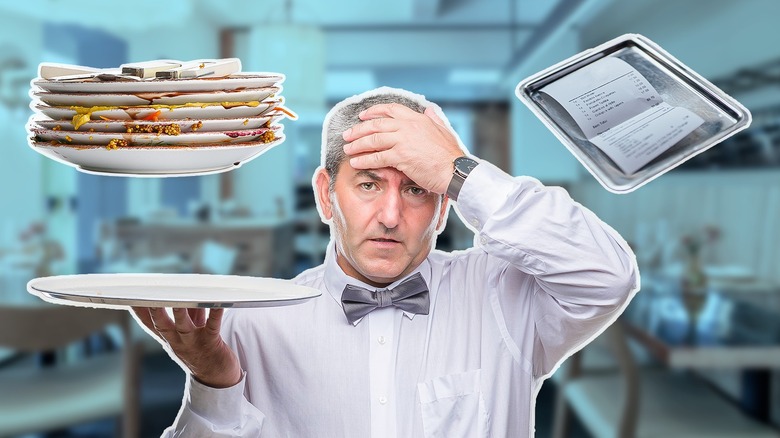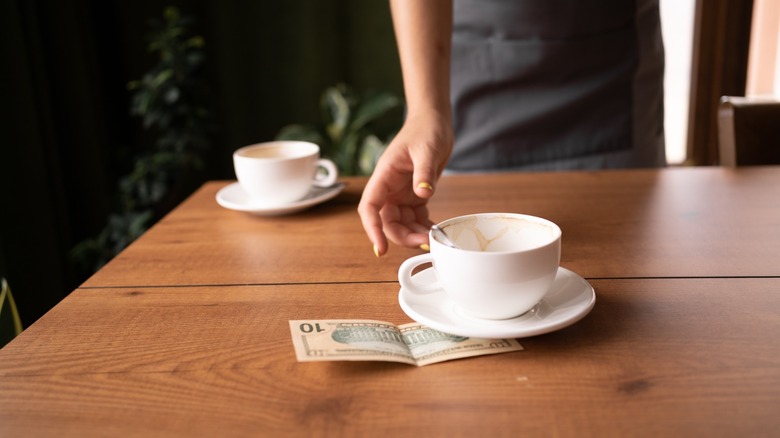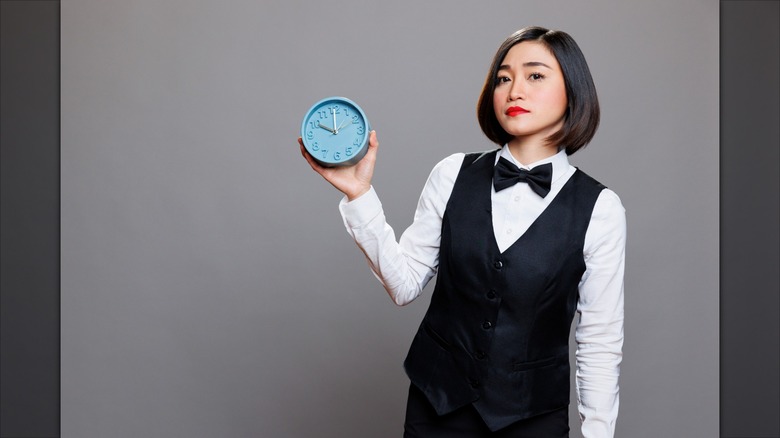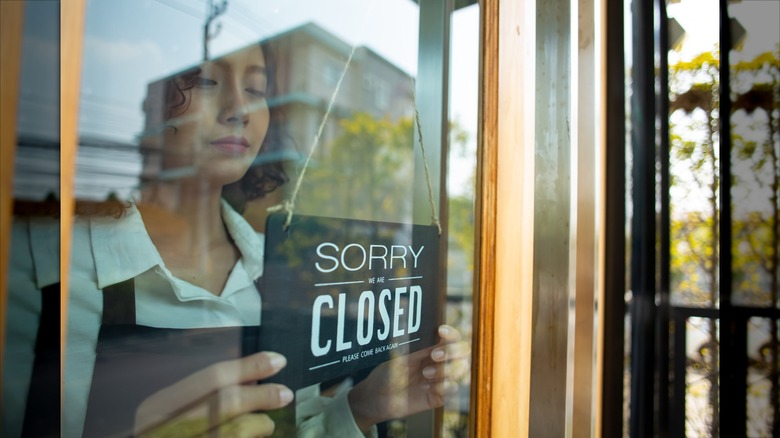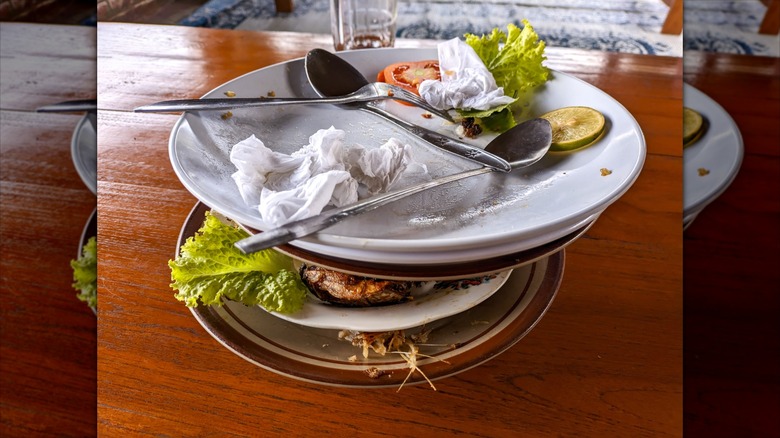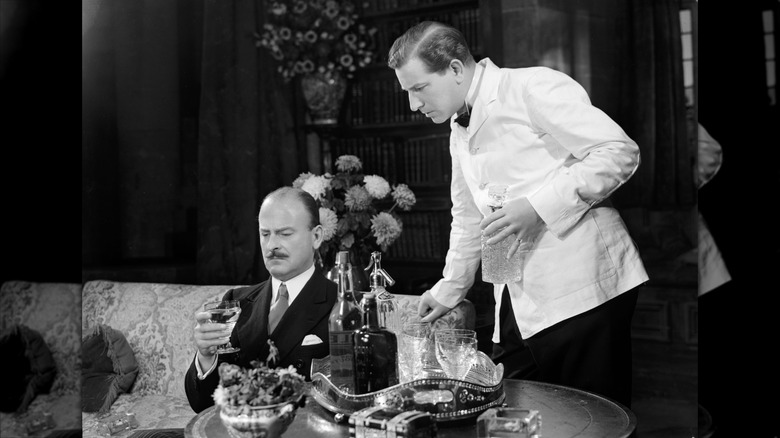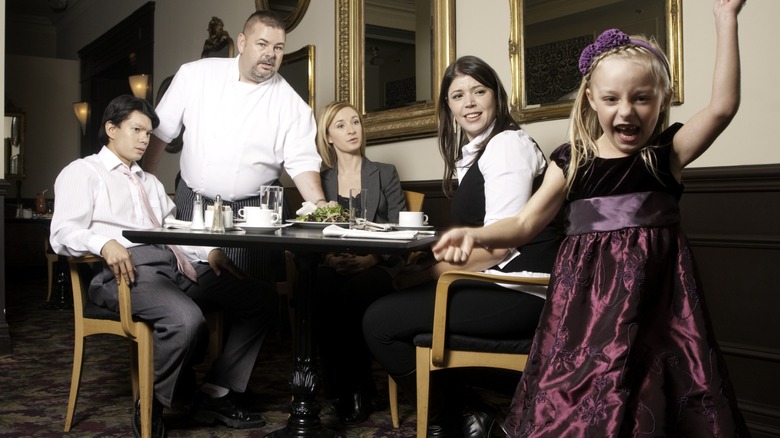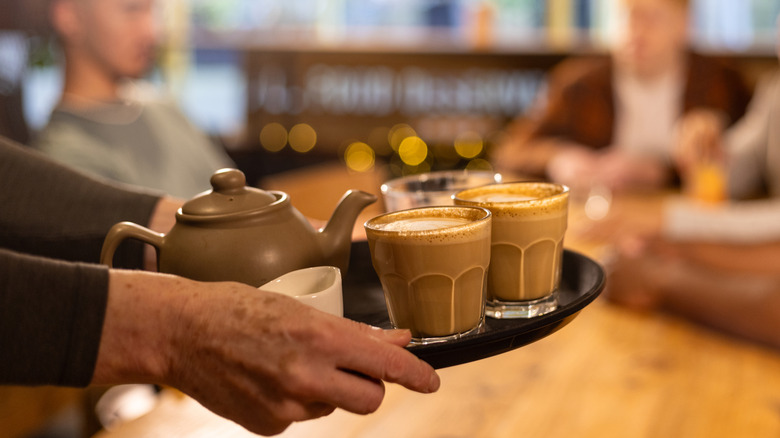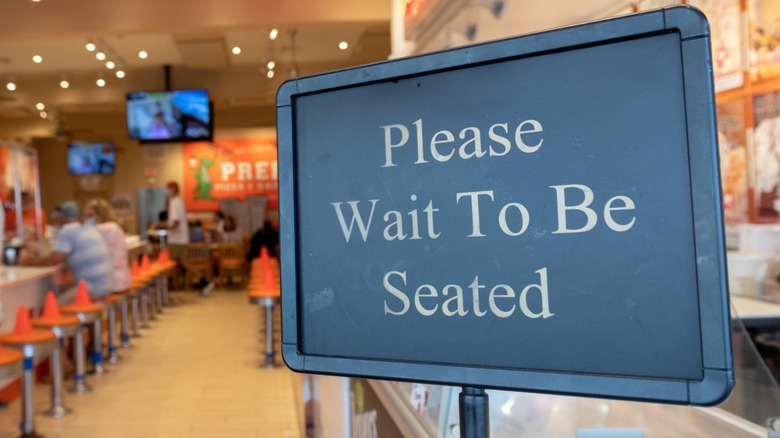13 Restaurant Behaviors You Might Not Realize Are Rude
Let's talk restaurant etiquette. Mainly, what seems fine to you might really send servers into a secret tailspin. But seeing as it's their job to stay polite and grin through any (absolutely) gripe-worthy faux pas, we took it upon ourselves to offer up a little PSA on some restaurant behaviors you might not realize are rude.
To be fair, we highly doubt anyone's going out there, taking their seat at their neighbourhood diner and trying to be, well, a "bad diner." Most of us are actually quite benign, just out here trying to enjoy one single night off from cooking, not secretly waging psychological warfare against the waitstaff. But, somehow, between bottomless mimosas at brunch and menus that may not have exactly what you hoped to order, the eternal mystery of whether to stack your plates (more on that later) inevitably arises. We want you to choose wisely. And because there's a lot of gray area when it comes to restaurant manners, we decided to go straight to the source.
We dove deep into Reddit threads, TikTok shoutouts, and expert articles to find out which seemingly innocent diner moves actually make restaurant workers quietly scream in the walk-in fridge. The goal isn't guilt. It's growth! So grab your fork, settle your bill (before leaving immediately), and let's dish about the table-side habits that might be sending the staff into full-on side-eye mode, without you even realizing it.
1. Tipping 15%
We once tackled the question of what the rules for tipping in a pandemic were. In that same spirit, while budget concerns are still here in 2025, many diners still struggle with how much to tip. We get it, especially with all these modern hospitality tipping systems that are enough to make one's head spin. Once upon a time, 15% was the golden standard. Millennial diners grew up with that percentage point burned into their brains as the polite, post-service cherry on top. However, just as belly button rings and ultra low-rise jeans have been retired, so too has that old-school gratuity equation.
These days, 18% to 20% (and often more) is the new normal. After all, these servers aren't just carrying trays. These are the restaurant warriors out here juggling packed sections of sometimes surly suppers, and fielding requests to bend over backwards. So, when you're calculating that tip total, think of it as part of the full dining experience (maybe theirs, not just yours).
One last trap many diners fall into is tipping on the post-discount total. You used a coupon or gift card, maybe got a two-for-one deal? Great! But your server still hustled just as hard before that code got scanned, and the expectation in the U.S. is to tip on the pre-discount amount. Tipping standards are "movin' on up," and your tip should, too.
2. Lingering after paying
Consider this scenario: the dinner rush is winding down and you've just paid the check. The vibe is high and the conversation is flowing. Maybe blame that third espresso martini, but something has you full-on buzzing and wishing the night would never end. Totally fine, right?
The short answer is no, not really. While it feels harmless to linger, hanging out long after you've settled up is one of those unintentional restaurant faux pas that quietly drives servers wild. What you may not realize is that each table represents potential income for a waiter, and when you "camp out," you're unknowingly putting their tip total in a chokehold. Especially during peak hours, a table essentially held hostage can mean another group of hungry guests left waiting, and another missed round of earnings.
It's not so much about rushing you out as it is about fairness. Think of it like passing the baton in a relay race. You've had your meal, even snapped your meme-worthy dessert selfie, and now it's time to hand off that table so someone else can have theirs. So, we now have confidence in your ability to correctly answer the question: Is it ever acceptable to stay at a restaurant after paying your bill? Go, (literally) make us proud.
3. Arriving just before closing
Moving on to those inevitable moments when late-night cravings strike. You roll up to your favorite spot, glance at the door, then at your watch, and feel an influx of relief and near jubilation. Score! They're still open for another 10 minutes! You slip inside, thinking you've beaten the clock and feeling like a total baller. And yes, while this is technically true, in the restaurant world, you've just basically made the ultimate faux pas.
Let us reiterate: Arriving right before closing isn't the same as dining during regular hours. The kitchen crew has already started breaking down stations, wrapping ingredients, and dreaming about what they will do when they finally get to go home after dealing all day with our hangry customers. This is the time when servers are deep into side-work mode. So, when you stroll in for a "quick bite," the whole process is rendered back to square one.
It's not that they don't want to feed you, but that 9:55 p.m. order at a cafe that closes at 10 p.m. can easily turn into an extra hour of labor behind the scenes. If it's within 15 minutes of closing, maybe just keep trekking, or consider grabbing takeout instead.
4. Stacking plates
It feels helpful, right? You're done eating, you stack the plates neatly, feeling generous for going a little out of your way and keeping your server in mind. Look at you, you model diner.
The thing is that this fantasy superstar diner plot has a tricky twist. That good intentioned "helpfulness" could actually spell pure spill-waiting-to-happen energy to a seasoned server. You see, most restaurant staff have a specific rhythm they have adopted when its comes to clearing a table. It is a painstakingly developed dance in most cases. When guests start stacking (bless their hearts), that entire flow is thrown off.
Servers know which plates balance safely, and how to load them on their trays so nothing crashes. So, that "gift" of your eager rearranging can turn more into a nightmarish, teetering tower of doom. Honestly, the best way to help is to just sit back, relax, and let them do their thing. Think of it like the kitchen in the film "Ratatouille," organized chaos that works because everyone stays in their lane. Your server doesn't need a sous chef at the table.
5. Not making eye contact with your server
Ordering without looking at your server might seem like no big deal. Maybe you're reading the menu, or busy chatting with friends you have not been able to catch up with for quite some time. Nothing wrong with that, but it can feel surprisingly dehumanizing from the server's perspective, to be on the receiving end of ... zero. Servers are people, too, after all, not just background characters in your dramatic dinner story narrative.
Even just a little eye contact wordlessly says to your waiter, "Hey, I see you, and I appreciate you taking my order and serving me today." It's kinda like the restaurant version of a polite handshake. It's a basic courtesy that makes everything go smoother. The difference between glancing up versus keeping your gaze glued to your phone or menu can truly set the tone for the entire interaction.
You don't have to make intense, unblinking eye contact. In a nutshell, just nod, meet the eyes, and acknowledge the human taking your order.
6. Waving down staff with a snap or wild gesturing
If you've ever snapped your fingers at a server, please just pause with us a moment, take a deep breath, maybe even apologize to the universe while promising never to do it again. Snapping, flailing your arms wildly, or loudly yoo-hooing across the room doesn't speed things up. It actually just sends stress signals rippling through the entire dining room, with the server taking the brunt of that nerve-rattling energy.
Before barking at your server, maybe consider they are juggling multiple tables, and the odds are very good they've already clocked your empty glass and are heading your way as fast as they can. When you animatedly wave at them like you're hailing a New York City taxi, it breaks that rhythm and adds unnecessary tension to an already pretty hectic and fast-paced job.
If you truly need to get a server's attention, there are decidedly more polite, lower-drama ways to go about it. A small hand raise and a calm "excuse me" works perfectly. You'd be surprised how, when you take that route, and simply relax a bit, servers will be right with you ... in a snap.
7. Yelling your order
Many servers have to deal with that moment when diners (unbeknownst to them or not), bring their outside voices in. We do understand that restaurants can get loud, but between sizzling skillets, clinking glasses, and the table next to you singing a rousing rendition of "Happy Birthday" and blowing out candles, you might feel like you need to shout just to be heard. Nine times out of 10, however, there really is no need for such extremes. Servers are trained to tune out the noise and still catch your order. When someone starts yelling right in their proximity, it's jarring, and so unnecessary.
What you can do instead, while using your indoor voice, is simply leave the proverbial ball in your server's court. Let them lean in if needed. They'll also ask questions if they can't hear you. The goal is communication, not domination.
8. Speaking at a whisper
At the other end of the volume spectrum lies the mysterious "whisper orderer," that diner who goes nearly silent the moment the server appears. Why this happens is one of life's great restaurant mysteries. Suddenly, the customer who was mid-laugh two seconds ago morphs into a voiceless mime.
Servers, bless them, are not equipped with bat-level hearing. Straining to decipher a too-hushed order over the volume of a packed dining room is not only stressful, but a surefire recipe for miscommunication. Then, when your whisper-order of "no onions" is overheard as "extra onions," it brings tears to both parties' eyes.
Just as we established moments ago, you don't need to shout, but speaking clearly at a normal conversational level is legit peak restaurant etiquette. The key here is confidence. There's nothing to be shy about. So, the next time you're tempted to lower your voice to a whisper, just remember that servers are trying to make sure you get exactly what you want. Help them out by turning the volume up a few notches.
9. Unhinged menu modifications
Riddle us this: Are you actually the bad guy for ordering off-menu at a restaurant? Could your "little" menu tweak really be that one annoying request a restaurant chef never wants to hear? It is a spectrum of sorts, if you will. Because servers get it, truly. Allergies, intolerances, and strong ingredient aversions are part of the dining world. There is nothing new about that, and no one's trying to ban gluten-free bread or the lactose-intolerant. That being said, there's a fine line between a simple menu alteration and what can only be described as culinary fan fiction.
If your request changes the dish so dramatically that it no longer resembles what's actually on the menu, that's more of a metamorphosis than a modification. Removing a garnish? No biggie. Nixing half the ingredients and then asking to add substitutions that scream high-maintenance queen — that's when it might be best just to order something else entirely.
Every kitchen has a rhythm, and extreme customization can throw that into chaos. Cooks spend time building each dish to work as a whole, and when you alter it too much, the structure (and flow of service) often collapses. You might still get your Frankenstein meal, but at the cost of some very frazzled kitchen staff.
10. Getting too personal
Servers are friendly. It is literally part of the job. They'll laugh at your jokes, remember your drink order, and make you feel like you're the star of the show. But don't get it twisted. That warmth you're feeling from your server is professional courtesy, not an invitation to flirt, pry for personal details, or (heaven forbid) touch.
Asking intrusive questions or commenting on someone's appearance crosses the line from friendly to uncomfortable in a New York minute. And touching? Absolutely not. Not the arm, not the shoulder, not even the elbow. Hear this, dear diner, the only thing you should be reaching for is your fork.
Your server is there to provide great service, not emotional labor or awkward banter about their weekend plans. Even if you're just "being nice," what feels like harmless banter and conversation to you can read as boundary-blurring forced intimacy to someone who's stuck smiling through it until their smoke break rolls around. Just keep it polite and professional. Your financial tip is appreciation enough. Chances are, anything beyond is not as charming or welcomely received as you may think.
11. Letting the kids run wild
Kids in restaurants can be delightful. Tiny chaos goblins using the dining room as a playground? Less so. Servers are already juggling hot plates, trays of drinks, and unpredictable dining adults. Dodging toddlers gone rogue shouldn't be part of this particular culinary circus.
It's totally fine for kids to be active and curious. They're kids, after all. The trick is keeping the chaos contained. Use this opportunity to teach them restaurant manners early. Bring coloring books and order something fun off the menu to keep their mouths busy. The sky is the limit for ways to creatively teach your tots eatery etiquette. Most parents already do this beautifully. It's the "free range" few who give the rest a bad rap. In a restaurant, the only thing that should be "free range" is the responsibly sourced special of the day.
Simply put, servers aren't paid to babysit or referee your kids, adorable as they may be. Make it a point to corral the kiddo chaos with grace when dining out, and you'll have every server silently saluting you.
12. Helping the server serve
When your server approaches with an armful of plates or a tray full of drinks, your instinct might be to jump in and "help." But as it turns out, that well-intentioned good deed can backfire spectacularly. You see, servers have their own choreography of sorts, where every plate, cup, and saucer is part of a practiced routine. One unexpected grab, and that elegant balance breaks (along with some glasses most likely).
Reaching for plates, lifting glasses off trays, or trying to "speed things up" actually slows everything down. It can throw off a server's grip, mess up their system, and lead to a big mess ... literally. They've got it under control, promise.
The best way to help is to simply make space. Move your phone or elbows off the table, and let them set things down safely, according to their system. They'll appreciate your patience far more than your sudden grab for that precariously perched seafood platter.
13. Seating yourself
You walk into a restaurant, see an open table, and think, "Perfect! I'll just sit here." It seems harmless enough, but for restaurants, it can mean pure anarchy. Those who have never worked in a restaurant may not realize this, but seating isn't random. Hosts and servers follow carefully balanced rotations, including assigned sections, to make sure everyone gets an even workload and the kitchen doesn't implode.
When you seat yourself, you're throwing off that delicate ecosystem. Suddenly, a section might get overloaded while another sits empty, and the person assigned to your "chosen" table might not even be on shift yet. The result is a woeful mixture of confusion, delays, and one very frazzled host struggling to somehow fix the chaos your impatience just unleashed.
If the host stand is empty, wait a minute. Someone will come. If you really must ask, do it politely. Asking for the table you want is definitely better than taking liberty and sitting yourself down wherever you please. It's all about respecting the fragile rhythm that keeps restaurants running smoothly. And we all love smooth operators.
